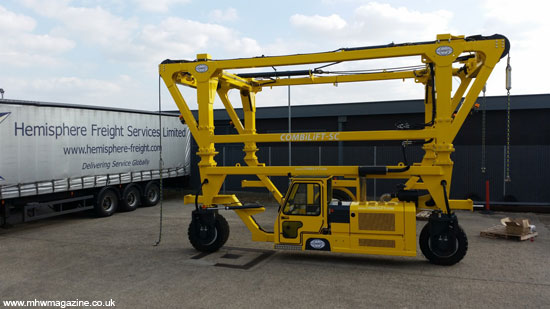
If we look at the progression of the fork-lift truck over the 21st century, it is not only the form that has changed but the technology fundamental to them. A great example of this is Linde’s, who will be awarded for pioneering something truly innovative.
The FLTA (Fork Lift Truck Association) praises companies for their modern creations and innovations at a yearly conference in Telford, and Linde’s will be presented for an award there in February 2015.
Linde’s shortlisted technology harnesses a unique electronic driver assistance system that displays a range of digital prompts warnings and indications that give the operator a superior overview of the operation. This system states to the operator the load weight on the fork arms, the current lift height, the tilt angle of the fork arms, the load centre and finally the maximum lift height the load can be raised too based on the other digital indicators.
But digital interfaces, screens and tracking systems pioneered by Linde are a far-cry from the humble beginnings of the fork-lift truck. And when we look at conventional (in terms of size and weight capability) fork-lift truck models used commonly in a warehouse scenario we observe how they all take and resemble a certain tried and tested form for a good reason.
Revolutionary Designs
From the revolutionary counterbalance truck, the reach truck, the multi-directional fork-lift, to the cargo and warehouse varieties these products are designed to give the user the most streamlined, manageable and easy-to-operate interface as possible. The various selections of models that are available on the global market is vast, the catalogue of differing shapes, sizes, specifications, capabilities and ergonomical features at the disposal of the operator and business.
The consistency to this form is no surprise, however companies like Doosan, Hyundai and Combilift - including their subsidiaries – having become synonymous with this innovative variation and pioneering technological advancement in logistics equipment. But what prompts such change? When businesses are met with dynamic, fast-paced change the demands for more ingenious models of the lift variety are in high demand.
You can anticipate the nature of some of these dynamic challenges in the 21st century. Whether it be the burdens placed on a business from the ever-expanding e-commerce sector of the information age, or the reality facing businesses in the expanding logistic challenges of a large domestic port, these climates have facilitated and intensified the rate of technological progression within heavy industry stock. Operations in a domestic port only run smoothly as the chain reaction of processes and people meet seamlessly; technology has to simplify this. Clearly certain technologies are involved to make this logistic-intense, practically complicated and labour intensive operation as unified as possible.
And on this chain reaction of logistical processes that enhance, for example, a port operation, there is a particular Combilift model – a distant cousin of the traditional fork-lift – that wholly revolutionised this process. That process being the handling of the familiar and standardised metal freight container used worldwide.
The Combilift Straddle Carrier
Martin McVicar, founder of Combilift in 1998 would – just a few years later – be included in the well-respected group of pioneering companies introducing progressive and innovative technologies and solutions within the heavy industry and fork lift truck circles. On first inspection, the engineering of materials and the form of this machine are bizarre, intelligent and intriguing, but the CLSC was innovative in its own right. Its form is frame-like, yet when the operator is in the driver’s seat the ingenuity of this machine comes to light as you can see the complexities of its design. Moving its composite parts over the standardised metal freight container the lift can position and move in a huge variety of angles and combinations to transport these bulky loads efficiently.
There have been other similarly staggering innovations in the engineering of materials to create these heavy industrial sector machines.
Firstly, the Hyster Big Truck Company. Hyster has produced some staggering machines, despite it being a very big boy’s toy sounding noun to attach to a company. With the introduction of the staggering 36-48 tonne model at the upper end of their specification we are observing an exceptionally powerful machine capable of lifting the equivalent weight of a small aeroplane. And with the staggering range of complex customisation, these industrial fork-lifts can be tailor-made to the needs of any demanding and intensive operating environment.
Eco Innovation
Secondly we can consider innovation of a different, less power-centric kind. The world’s first ever diesel-engine/lithium-ion battery hybrid fork-lift took centre stage at 2011’s CeMAT exhibition. The GRENDIA EX 4.0 to 5.0 tonne is or was one of a kind. Adorned with a gleaming teal shade and a bright ‘hybrid’ logo it seemed there was a sort of upping of the ante within the forklift industry. With the advent of all things hybrid new models have been introduced saving considerable energy – these machines are a smart and progressive move for any 21st century eco- conscious business.
From the modest CESAB M325 to a 45 tonne Hyster these post-modern incarnations of the humble fork-lift arguably barely resemble a fork-lift truck, yet are still emphatically within this category as the heavy industry market continues to innovate.
As heavy industry machinery moves towards more powerful, bulky and composite machines they will continue to take more innovative shapes as the demands for capabilities grow. The CLSC stands tall amongst all of these innovations whether it be in power, emission volume, size or design. Upon purchase it is interesting to view how the machine is put together as it arrives as such a composite piece of machinery. However, once it has been constructed this machine can expand, be hoisted higher, or grasp containers at various angles or heights. Truly innovative.
"Hi-tec Lift Trucks are a fork-lift hire company based in Wellingborough, Northants stockists of a wide variety of CESAB models"
http://www.askhitec.co.uk/